|
Lotus Europa
Debut: 2006
Maker: Lotus
Predecessor: no |
|
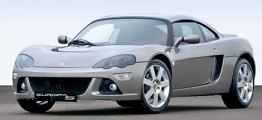 The
1966 Europa was the first mid-engined machine built by Lotus and one of
the earliest of its kind in the world. Lotus produced some 8500 units
of Europa during the next 10 years, making it one of the most
successful Lotuses ever made. Perhaps because of such success, Lotus
reapplies the name to its latest GT car. The
1966 Europa was the first mid-engined machine built by Lotus and one of
the earliest of its kind in the world. Lotus produced some 8500 units
of Europa during the next 10 years, making it one of the most
successful Lotuses ever made. Perhaps because of such success, Lotus
reapplies the name to its latest GT car.
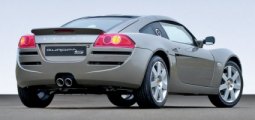 Sharing
the same profile and windscreen with Elise, Europa S is clearly
yet another derivative from that Lotus core model. However, Europa S is
engineered to be softer, more comfortable and easier to drive to
attract another kind of customers. It has a 30mm stretch in wheelbase
to give more interior room. It has lower door sills and higher roof to
make access slightly easier. Its cabin has more standard equipment (air
con, twin airbags, power windows, central locking, a cheap sat nav and,
well, carpets). It has slightly more boot space (up from 112 to 154
liters) thanks to a longer rear overhang. Its suspensions are set
softer to provide supple ride. Moreover, it has the peaky Toyota engine
replaced by Opel's 2.0-liter 16V turbocharged engine, with 200
horsepower and very useful 200 lbft of torque on tap to ease driving
effort. Now you may realize that Europa S is actually a repackaged
version of the now-defunct Opel Speedster / Vauxhall VX220 ! Sharing
the same profile and windscreen with Elise, Europa S is clearly
yet another derivative from that Lotus core model. However, Europa S is
engineered to be softer, more comfortable and easier to drive to
attract another kind of customers. It has a 30mm stretch in wheelbase
to give more interior room. It has lower door sills and higher roof to
make access slightly easier. Its cabin has more standard equipment (air
con, twin airbags, power windows, central locking, a cheap sat nav and,
well, carpets). It has slightly more boot space (up from 112 to 154
liters) thanks to a longer rear overhang. Its suspensions are set
softer to provide supple ride. Moreover, it has the peaky Toyota engine
replaced by Opel's 2.0-liter 16V turbocharged engine, with 200
horsepower and very useful 200 lbft of torque on tap to ease driving
effort. Now you may realize that Europa S is actually a repackaged
version of the now-defunct Opel Speedster / Vauxhall VX220 !
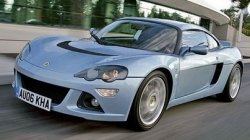 143 mph
top speed, 0-60 in 5.6 seconds and 0-100 in 13.8 seconds are good
numbers for a GT car costing £33,000, or equivalent to the base
Porsche Boxster. On the down side, the low-revving character of the
Opel engine (it reaches peak power at only 5400rpm), its uninspiring
exhaust note and its slow throttle response are disgraceful for a GT
car. Lotus should have given it a world-class V6, but sadly, it did not
want to make the necessary investment. 143 mph
top speed, 0-60 in 5.6 seconds and 0-100 in 13.8 seconds are good
numbers for a GT car costing £33,000, or equivalent to the base
Porsche Boxster. On the down side, the low-revving character of the
Opel engine (it reaches peak power at only 5400rpm), its uninspiring
exhaust note and its slow throttle response are disgraceful for a GT
car. Lotus should have given it a world-class V6, but sadly, it did not
want to make the necessary investment.
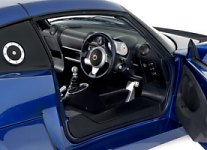 Predictably,
the handling is softer than Elise but still remarkable by
class standard. This is a mid-engined machine with very low center of
gravity and low inertia, thanks to the lightweight aluminum chassis and
composite body. It carries 135 kg more than Elise but still under 1
ton. That eases the load to the 225-section rear tires and 288mm
diameter ventilated disc brakes thus return remarkable roadholding and
braking. The steering continues to be light and feelsome. Compare with
Elise, its handling has lost some sharpness and precision, but by
touring car standard it is by all means admirable. Predictably,
the handling is softer than Elise but still remarkable by
class standard. This is a mid-engined machine with very low center of
gravity and low inertia, thanks to the lightweight aluminum chassis and
composite body. It carries 135 kg more than Elise but still under 1
ton. That eases the load to the 225-section rear tires and 288mm
diameter ventilated disc brakes thus return remarkable roadholding and
braking. The steering continues to be light and feelsome. Compare with
Elise, its handling has lost some sharpness and precision, but by
touring car standard it is by all means admirable.
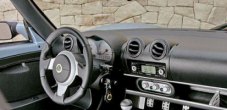
3 years ago we were happy with
Opel Speedster Turbo. Today the same
ingredients can no longer satisfy us, especially when the price has
been increased from £26,000 to £33,000 and
the car has been rebadged to Lotus. If you want the ultimate driving
thrill at this price, Elise S is always the first choice. If you also
take comfort and usability seriously, then choose Porsche Cayman or
Audi TT instead. Europa S can satisfy neither requirements, nor it is a
good compromise between the two sides. Lotus has not produced a car so
disappointing for many years. |
| The
above report was last updated on 20 Sep
2006. All Rights Reserved. |
Europa SE
|
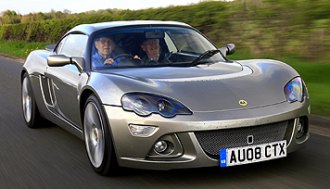 No
matter in terms of sales figures or reputation, Lotus Europa S has been
disappointing. Now its position is being replaced by Europa SE, a more
powerful and more capable car. First of all, its 2-liter turbo engine
has been tweaked to produce a more competitive 225 horsepower and 221
lb-ft of torque. Lotus claims very minor improvement in performance –
5.5 seconds instead of 5.6 seconds for 0-60 mph, 13.0 seconds instead
of 13.8 sec for 0-100 mph, while top speed is even unchanged at 143 mph
– but in reality it feels noticeably stronger. No
matter in terms of sales figures or reputation, Lotus Europa S has been
disappointing. Now its position is being replaced by Europa SE, a more
powerful and more capable car. First of all, its 2-liter turbo engine
has been tweaked to produce a more competitive 225 horsepower and 221
lb-ft of torque. Lotus claims very minor improvement in performance –
5.5 seconds instead of 5.6 seconds for 0-60 mph, 13.0 seconds instead
of 13.8 sec for 0-100 mph, while top speed is even unchanged at 143 mph
– but in reality it feels noticeably stronger.
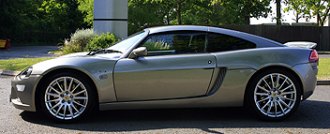 The
chassis is basically unchanged, but it employs wider tires, new
lightweight alloy wheels
(now the rear ones grown to 18-inch) and larger, 308mm AP disc brakes.
Its handling is more capable. It shows less understeer in corners than
the old car, while
keeping the compliant ride unchanged. The extra torque makes overtaking
more
effortless. The
chassis is basically unchanged, but it employs wider tires, new
lightweight alloy wheels
(now the rear ones grown to 18-inch) and larger, 308mm AP disc brakes.
Its handling is more capable. It shows less understeer in corners than
the old car, while
keeping the compliant ride unchanged. The extra torque makes overtaking
more
effortless.
The interior is now thoroughly leather
wrapped, so no more complaints for nasty plastics. The leather seats
look terrific. However, Europa is still a basic driving tool compare
with most other coupes from mass manufacturers. Its cockpit is narrow,
noise insulation is poor, build quality is inconsistent and access
to the cabin across the wide sills is not easy. Moreover, you have to
put up with
the uninspiring noise of the turbocharged Ecotec engine. As a GT, it is
still too compromised. |
| The
above report was last updated on 21 Jul
2008. All Rights Reserved. |
|
|